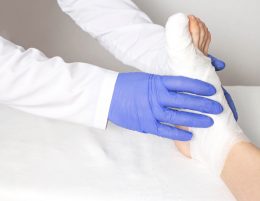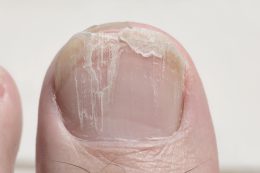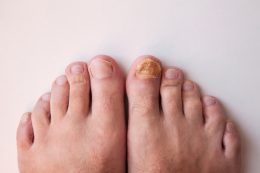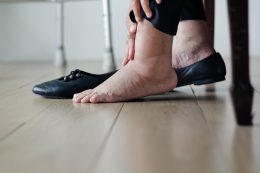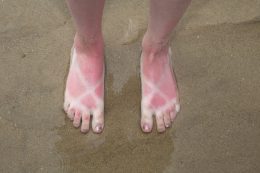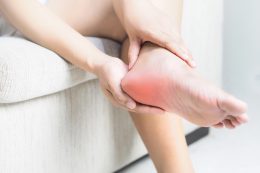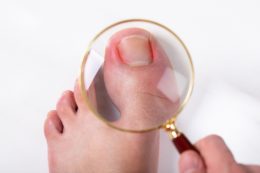Posted by wpadmin …
Explaining Frostbitten Feet Treatment
Frostbitten Feet? Your Treatment Options
Now that the cold weather has settled in, the risk of frostbite injuries increases exponentially. If you are experiencing frostbitten feet, here are some treatment options that you can pursue with the aid of a podiatrist.
Where Does Frostbite Happen?
Frostbite most commonly occurs in the extremities, including your feet. It can also affect your fingers and face.
Symptoms of Frostbite in Feet
As stated by the Mayo Clinic, these are the common symptoms of frostbite:
Initial Symptoms
As frostbite is a progressive injury, symptoms can change over time. Some of the first symptoms you might notice are cold skin and a prickling feeling in the affected part of your body. If you have been recently exposed to cold temperatures and these feelings persist, you should contact a doctor immediately.
Numbness
Cold temperatures can numb the body. If your foot is frostbitten, it can sustain a feeling of numbness for a prolonged period of time.
Discolored Skin
Depending on the frostbite’s severity and your skin tone, a noticeable discoloration can vary in hue. It can range from any of the following shades:
- Red
- White
- Yellow
- Purple
- Brown
- Ashen
- Blue
If you notice any of these colors on your skin after long-term exposure to extreme cold, be sure to contact a doctor or visit an emergency room immediately for treatment.
Change in Skin Appearance or Texture
The texture of the skin around the frostbitten area can assume a hard or waxy appearance. This indicates that the skin has been altered by the temperatures and could be a warning sign of further frostbite symptoms.
Mechanical Difficulties
Are you noticing a feeling of clumsiness or difficulty maintaining balance? This could be due to the stiffness that frostbite can cause in your joints and muscles.
Blistering
After rewarming your skin, some severe cases of frostbite can produce blistering. While blisters are more commonly associated with heat, this should be taken as a serious warning sign if you have recently warmed back up after being exposed to the cold.
Types of Frostbite
There are four stages of frostbite. From least to most severe, these include no frostbite, frostnip, superficial frostbite, and deep frostbite. Worse varieties of frostbite will progressively affect deeper layers of skin as a result of the condition.
Treatment for Frostbitten Feet
Depending on the severity, treatment options for frostbitten feet can vary. These include:
Rewarming
In more mild cases of frostbite, a simple rewarming of the skin might prove effective. This involves soaking your injured foot in warm water for a period of time.
Medication
Your doctor might prescribe you medication like painkillers, antibiotics, or an anti-clotting treatment to protect your body against further injury and discomfort. The proper course of medication will be determined during examination and diagnosis.
Bandaging
To help your injured foot heal, your doctor might decide to bandage your foot or wrap it in a loose dressing to protect it against further injury. The method of bandaging will change depending on how severe your frostbite is.
Therapy
Depending on your condition, your doctor might recommend a therapeutic treatment to aid in recovery. This often includes treatments like whirlpools or physical therapy if some mobility has been affected by the frostbite.
Surgery
If tissue on the foot has died or decayed past saving, your doctor might insist on surgical intervention. This could include a targeted removal of the dead tissue around the frostbitten area or complete amputation of the foot if not enough of the foot can be salvaged.
How to Prevent Frostbitten Feet
The primary way to prevent frostbite is to protect your extremities from extreme cold temperatures. Some simple ways to do this are:
- Wear comfortable layers of winter-appropriate clothing
- Do not leave any openings around your boot or shoe where water or snow can become trapped
- If your clothes are wet, change immediately into dry ones
- Stay hydrated and avoid alcohol
- Act quickly if you notice any symptoms of frostbite developing
Great Treatment for Frostbitten Feet in Eastern Maryland
As the winter trends downward, it is important to recognize these symptoms of frostbite. If you are noticing these signs on your own feet, contact our team of expert podiatrists today to discuss treatment options. If caught early, more effective treatment and recovery can be made possible.
Broken Toenail Treatment Options Explained
Enjoy Healthy Recovery from Broken Toenails
A broken toenail can feel painful and make walking difficult. If this happens to you, you should seek treatment as soon as possible to support healthy healing.
Today, we are going to provide a comprehensive overview of treatments for broken toenails. If you are experiencing this condition, please make an appointment with a podiatrist as soon as possible.
How Do You Know if Your Toenail is Actually Broken?
At a glance, your toenail might seem broken when it is actually still intact. Sometimes the nail is damaged but not completely detached or in need of removal.
Signs of toenail trauma that likely require medical treatment can include:
- Bleeding
- Swelling, redness, and/or throbbing over multiple days
- Intense and/or persistent pain
- Splitting, tearing, or cracking in the nail
- Separation between the nail and nailbed
- A dark reddish or purplish spot underneath the nail
- Abnormal coloration
- Thickened nail, partial or whole
If the toenail has become infected, a person may also notice the presence of pus or experience a fever. If you notice these additional symptoms, seek medical treatment immediately. The infection might require antibiotics or other intervention.
If the Toenail Requires Removal
Should it be necessary, a podiatrist can remove the nail while preventing further damage to the toe. If part of the nail can be preserved, the podiatrist can trim the parts that are broken while leaving the healthy portion intact. Attempting an at-home nail removal is not recommended, as it could result in further injury and increase the risk of infection.
Treatment Options for Borken Toenails
Trimming
As mentioned above, a podiatrist can sometimes trim around the injury to the nail rather than remove it. A partial toenail will grow back in less time than one that was stripped from the nailbed completely.
Complete Nail Removal
Severe injuries might require complete nail removal so that a new one can grow in its place. Podiatrists can determine this during an examination and use specialized equipment to extract the nail without causing further damage to the foot.
Artificial Nails
Artificial nails mimic the function of your natural toenail. A podiatrist may decide to apply one to your nailbed to keep it covered while the toenail regrows.
In some cases, artificial nails can become detached from the toe before the appropriate time. If this happens, contact your doctor and let them know that this happened, and make an appointment to receive a new one.
Keeping the Area Clean
Once the nail has been trimmed or removed, your podiatrist will recommend an aftercare plan. This will usually involve keeping the wounded area clean. In most cases, the easiest way to do this is by soaking the toe in a cleaning solution for a recommended period of time.
Changing Bandages Regularly
Frequently changing the bandages on your toe is essential for healthy recovery. Some times of day where you might want to do this can include:
- Before starting your day in the morning
- After soaking your toe
- After bathing or showering
- After getting home from work or a long outing
- Before going to bed
Before covering your toe with a new bandage, inspect the toe for any signs of infection like redness, pus, or swelling. Be sure to also apply an antibiotic ointment or petroleum jelly to the wounded area beforehand.
Wearing Comfortable Shoes
While your nail is healing, do not wear tight shoes or ones that place pressure on the affected toe. Instead, wear comfortable, closed-toed shoes when leaving home to protect your feet during the recovery process. At home, you can continue to cover your feet or leave them bare.
Taking Antibiotics for Infections
If your toe becomes infected, a doctor might prescribe a course of antibiotics to treat it. Be sure to remain consistent with taking them to prevent the infection from worsening. You can obtain a prescription either through your podiatrist, general practitioner, or walk-in clinic.
Get Treatment for Broken Toenails in Maryland
The Thomas Podiatry & Associates team is proud to be the Delmarva Peninsula’s leading foot care specialists. With multiple locations throughout Eastern Maryland, we can help you treat your broken toenail and create an action plan to support healthy recovery. To see one of our podiatrists, request an appointment online today.
Toenail Fungus: Signs, Symptoms, and Treatment
Identify Toenail Fungus Early to Get it Treated Sooner
Toenail fungus is a common ailment that many Americans experience each year. Fungal nail infections often start as white or yellow spots beneath your toenail, and if left untreated, can lead to nail discoloration, as well as thickened or crumbly nails, which can be painful. Even when treatment is successful, nail fungus often returns. Fortunately, by knowing the symptoms and being aware of prevention best practices, you can seek treatment quickly and easily and reduce the chances of reinfection.
Symptoms
According to the Mayo Clinic, many symptoms could indicate whether you have toenail fungus:
Thickened Nails
If your nails feel thicker than usual, this may be a sign of fungal infection. Compare your thicker nail to the identical nail on your other foot. If there is a notable difference, you should make an appointment with a podiatrist for an examination.
Discolored Nails
Fungal infections can also cause nail discoloration. You’ll often notice a whitish or yellowish-brown shade, which is a telltale sign that something in your toe needs treatment.
Brittle Nails
Brittle nails can crumble or have an unusual or ragged texture, which can cause uneven nail growth and pits in the nails. If you notice signs of brittle, crumbly, or ragged nails, it is essential to make an appointment to have your toes checked by a professional.
Distorted Shape
Infections may affect your nail’s ability to grow evenly and healthily. Brittle nails may also cause pieces to break off, creating an unusual shape. If your nail has an unusual shape and you do not remember chipping it, this may indicate an infection.
Foul Smell
A fungal infection can cause the toe to produce pus or create a foul odor on its own. If you notice an unusual smell, you should consider calling a podiatrist immediately.
Preventing Fungal Infections
By actively engaging in healthy foot care habits, you can prevent nail fungus, reinfections, and athlete’s foot, all of which can lead to the growth of nail fungus. Here are a few preventative habits that you can implement into your daily routine:
Wash Your Feet Regularly
Wash your feet regularly, especially if you wear open-toed footwear or have exposed your feet to untreated water. After washing your toes, you can also moisturize them to keep them soft and healthy. After touching an infected nail, you should always wash your hands.
Wear Flip Flops in Showers
Avoid taking showers in public facilities such as gyms or hotel rooms without wearing sandals or flip-flops. Otherwise, you run the risk of developing an infection. Additionally, always wear footwear while in locker rooms or pool areas.
Treat All Nail Injuries
Seek treatment for all nail injuries, even if minor. When caring for your nails, trim them straight across and smooth the edges using a file to avoid causing further damage.
Monitor Your Feet Closely
If you have diabetes, make it a habit to monitor your feet closely and notify your doctor of any sudden changes to your toenails.
Treatment
Fungal toenail infections can be challenging to treat. Your treatment will depend on the severity of your condition and the type of fungus behind the infection. There are several self-care strategies and over-the-counter products that may help, including:
Antifungal Drugs
Oral antifungal drugs are usually the first option for treating any infection because they work more quickly than topical drugs. Your podiatrist might prescribe you an oral antifungal medication to help a new, healthy, and clean nail slowly replace the infected part of your toe.
Topical Cream
Over-the-counter antifungal nail cream is another treatment option, which you rub into your infected nail(s) after soaking your foot. If a non-prescription cream doesn’t work, your doctor can prescribe you a stronger version.
Nail Removal
Some fungal toenail infections don’t respond to medicines. If other treatment options fail to heal an infected toenail, your doctor may need to perform a nail removal. By following post-removal care instructions carefully, you can ensure a healthier nail regrowth.
Get Treatment for Nail Fungus in Maryland
Getting nail fungus treated as soon as you notice symptoms is imperative for keeping your feet healthy and intact. Before arriving at your appointment, it’s a good idea to prepare by listing your symptoms, making a list of all the medications you are taking, and thinking ahead about any questions you may want to ask your podiatrist.
If you need nail fungus treatment in the Salisbury, MD area, contact us any time to make an appointment with our caring and dedicated staff.
A Guide to Diabetic Foot Amputation and Recovery
Will Diabetic Complications Require Foot Amputation?
Practicing good diabetes management and regular foot care is essential for preventing severe foot sores that are difficult to treat. Over 80% of diabetic foot amputations occur because of foot ulcers that do not heal. They can develop on any diabetic patient and should be addressed immediately – otherwise, you run the risk of needing an amputation. Here’s what you need to know about keeping your feet healthy and what happens if amputation is necessary.
Foot Ulcer Causes
Foot ulcers do not discriminate – anyone who has diabetes can develop one. Several factors can cause foot ulcers. Some of the causes can include a diminished sense of feeling in the foot, inadequate blood circulation in lower extremities, friction or pressure against the foot, or physical trauma.
The progression of diabetes over time may also lead to the formation of a foot ulcer. Some patients develop diabetic neuropathy, which reduces the sensation of touch. As a result, patients may not be aware of any damage they are causing to their feet. Diabetic neuropathy is easily detectable, so if you notice a lack of sense of touch in your foot, it is critical to make an appointment with a podiatrist right away.
Preventing Ulcers
You can significantly reduce the likelihood of developing a foot ulcer by following key practices that promote healthy feet. For instance, regularly inspecting your feet for any wounds or signs of bacteria and fungal infection is a great way to remain vigilant for warning signs.
You can also promote good hygiene by thoroughly washing and drying your feet at least once per day, with a focus on drying between the toes. Wearing clean socks and closed footwear every day, even around the house, can protect against any physical trauma to the foot.
Additionally, you can reduce the chances of foot ulcers by avoiding temperature-based treatments, such as heating pads. Monitoring and managing your blood pressure, controlling blood sugar with insulin, quitting smoking, and following a healthy diet can also bolster your efforts to prevent foot ulcers.
Foot Amputation Warning Signs for Diabetic Patients
It is crucial for those living with diabetes to pay extra attention to their feet because they are at higher risk of wounds not healing correctly. Some of the signs that you should look for include ingrown toenails, blisters, foul odors, plantar warts on the bottoms of your feet, and athlete’s foot, a scaly, itchy rash that causes pain.
Other symptoms may include swelling and/or redness, pain, or localized warmth in one part of your foot, indicating inflammation. You may also notice a large ulcer where the bone and muscle are visible that does not go away after a couple of weeks or show signs of progressive healing. If You notice any of these warning signs, be sure to contact your podiatrist immediately.
When is an Amputation Deemed Necessary?
An ulcer that does not heal and causes significant damage to your tissues and bone may require surgical removal or amputation. Usually, the first option is to treat the wound, remove the affected tissue, and monitor your progress. While some cases only require a partial amputation, others will necessitate the total removal of the foot. If an ulcer is life-threatening or has removed too much tissue from your foot, an amputation is usually necessary.
Who Performs the Amputation?
Whether your podiatrist will perform the amputation depends on if they are qualified to perform surgeries on the feet. If your foot doctor cannot complete the amputation, they will coordinate with qualified surgeons in their network whom they trust to provide you the best care possible. Other specialists, such as physical and endocrinologists, may also assist with your care before, during, and after an amputation.
While the thought of a diabetic foot amputation can be scary, forming diligent habits to care for your feet can increase the chances of prevention. You can help support healthy feet by working with a podiatrist who can assist you in managing and treating any warning signs. Doing so can considerably reduce the likelihood of developing an ulcer or damaging your foot due to numbness.
To learn more about diabetic foot treatments or to schedule an appointment with one of our caring physicians, get in touch with our office today. We look forward to helping you maintain healthy feet!
Diabetic Foot Wound Treatment Options
Diabetes can cause damage to the nerves in your feet, which results in a condition called diabetic neuropathy. According to the NIDDK, this lack of sensation can reduce your body’s ability to perceive pain in the feet, which would otherwise be a warning of a more severe condition. If the infection does not heal, it could worsen and develop into gangrene, which can result in a complete amputation of the foot.
If severe enough, Nerve damage may also change the fundamental structure, functionality, and appearance of your foot, which can lead to a condition called Charcot’s foot, which can damage your joints and soft tissue. Since many diabetic patients may not feel any pain in their feet, it is imperative to be mindful of your health. Here are some great ways to care for a diabetic foot wound.
Move Your Feet Frequently
Walking as often as possible encourages healthy blood flow to your feet, which can help your body fight the infection and heal. Activities that do not put much pressure on your feet, such as walking, dancing, swimming, cycling, or yoga, are all great ways to improve your circulation. You can also put your feet up while sitting or wiggle your toes throughout the day to encourage a healthy blood flow.
Always Wear Protective Footwear
Wearing protective footwear at all times – even when you’re indoors – is essential for healing a diabetic foot wound because it helps prevent further injury to your foot when your pain receptors are impaired. Athletic shoes with properly fitting socks can help prevent blisters and sores. When buying shoes, avoid materials like plastic or vinyl and ensure that you have enough room for your toes. Wearing protective footwear while you are outside can prevent you from inadvertently burning the bottoms of your feet on hot pavement or sand.
Check for Any Warning Signs
Checking your feet daily for warning signs of a foot wound can help you catch problems before they worsen. An excellent way to get into this habit is to perform a check in the evening when you take your shoes off for the night. Here are some of the most common problems to look for:
- Cuts, sores, ulcers, or discoloration
- Blemishes such as abscesses, blisters, warts, etc.
- Nail injuries such as ingrown nails and pus around the nail base.
- Fungal infections such as athlete’s foot
- Stark temperature differences in various parts of the foot
- If you notice any of these symptoms, contact a podiatrist immediately
Clean Your Feet Regularly
Cleaning your feet daily not only helps prevent infection but is a great way to feel refreshed at the end of a long day. After washing your feet with warm water, dry them thoroughly and apply talcum powder or cornstarch, including in between your toes. If you have corns or calluses, avoid treating them aggressively, as such an injury can lead to the development of an ulcer. It is also important to avoid soaking your feet in hot water, as doing so can cause them to dry out.
Don’t Cut Your Toenails Too Short or Deep into the Nail Base
Cutting your toenails keeps them from cutting and growing into your skin, but did you know that cutting too short or deep into the nail base can result in ingrown toenails? Trimming your toenails as needed after washing your feet is a vital habit for preventing foot wounds. Avoid cutting into the corners of your nail – instead, trim them straight across and then smooth each one out with a nail file. If you cannot see, reach, or feel your feet or otherwise have thick, yellow, or curved nails, you can have your foot doctor assist you.
Get Diabetic Foot Treatment In Maryland
While foot problems are common in people with diabetes, you can reduce your chances of developing any issues by regularly caring for your feet. In addition to moving your feet frequently, wearing protective footwear, and regularly maintaining your feet, you can work with your health care team to create a customized plan to help you manage your condition.
If you are currently struggling to care for a diabetic foot found, suspect that you have an infection, or have a callus with dried blood in it, contact Thomas Podiatry Associates today to schedule an appointment with our gentle and caring team. We look forward to helping you heal!
What are Some Nonsurgical Options for Plantar Fasciitis?
Reviewing Your Noninvasive Options for Pain Relief
Our feet already endure daily wear and tear while performing daily activities such as walking, running, and jumping. It should come as no surprise that some people may develop plantar fasciitis, which occurs when the plantar fascia ligament in your foot becomes inflamed and causes sharp, stabbing heel pains. While most cases resolve within a year with or without treatment, there are a few nonsurgical treatment options that you can use to relieve the pain.
Stretching
Stretching is an essential part of any plantar fasciitis treatment. Tight muscles in your calves and foot arches can make symptoms worse, but you can soothe or prevent the pain by performing a few easy lower body stretches. Calf stretches target the gastrocnemius muscle, which is located on the back portion of your lower leg, and arch stretches stretch the middle of your foot.
You can stretch your calves by standing an arm’s length from a wall, placing your right foot behind your left, and then slowly and gently bend your left leg forward. As you lean forward, keep your right knee steady and your right heel planted firmly on the ground. Hold the stretched position for at least 15 seconds and release before reversing the position of your legs. Repeat each side three times.
To stretch your arches, you can perform a few seated stretching exercises. One easy movement is to roll your foot back and forth over a foam roller or frozen beverage bottle for one minute per foot before crossing one leg over the other and grabbing your big toe, gently putting it toward you for 30 seconds. Repeat three times per foot.
Alternatively, you can place a resistance band or folded towel under both of your arches and gently pull the tops of your feet toward you, holding for 15 to 30 seconds for three repetitions.
Pain Relief Medication
In addition to techniques such as ice massages, over-the-counter pain relievers are one option for reducing pain and discomfort caused by plantar fasciitis. Nonsteroidal anti-inflammatory drugs such as ibuprofen, aspirin, or acetaminophen are all popular options for controlling the pain.
Alternatively, if your symptoms are severe enough to impact your quality of life, you may consider corticosteroid injections in the tissues near your heel bone, which can provide rapid pain relief that may last for weeks. For long-term pain relief, botulinum toxin injections can relieve pain for months. It is important to note that though corticosteroid injections can interfere with the healing process, botulinum toxin injections do not.
Physical Therapy
Research shows that customized physical therapy programs can be a highly effective treatment option for plantar fasciitis. Treatment can include ice applications and strengthening exercises that can improve walking and significantly reduce pain. Heel raises, ankle inversions, and plantar fascia stretches are examples of standard physical therapy exercises that you can do at home and in therapy.
Night Splints
Night splints stretch your calves and foot arches while you’re sleeping, which can help lower heel pain first thing in the morning. Additionally, taping your foot can support your arch, reduce strain, and correct overpronation throughout your day.
Orthotic Shoe Inserts
Orthotic shoe inserts can help restore natural gait with arch support and heel cups. Inserts also help distribute pressure evenly when you are walking or running, reducing the stress on your plantar fascia.
Compression Socks
Compression socks are one effective option for treating plantar fasciitis, which puts mild to moderate pressure on your heel and provides arch support. Compression socks are available in multiple styles, including ankle or knee-highs, which can also compress your calves, as well as numerous uses. For instance, certain brands are better suited for athletic activity, while others are more viable for long periods of standing.
Supportive Footwear
Patients with plantar fasciitis often require supportive footwear for achieving maximum comfort during physical activity. While there is no “one-size-fits-all” solution when it comes to footwear, there are many options available to choose from in running shoes, walking shoes, hiking shoes, and sandals.
Losing Weight
Obesity or excess body weight is a considerable risk factor in developing plantar fasciitis due to the added stress that extra weight puts on your plantar fascia. Losing weight can not only reduce any pressure on your feet but can also make you feel better about yourself all around.
For most cases, the standard treatment for plantar fasciitis is plenty of rest, stretching, pain relief medications, ice massages, orthotics, and low-impact exercises for strengthening your muscles and maintaining your weight. Chronic and deliberating cases may require more extensive nonsurgical treatment options, such as injections or regenerative medicine.
Get Plantar Fasciitis Treatment in Maryland
If you are in Maryland looking for Plantar Fasciitis treatment, make an appointment with us today.
How Treat Sunburn Blisters on Feet
Summertime has arrived, and with that comes many days spent outdoors. Whether at the shore, in your backyard, or walking with open-toed shoes, you can be exposing your feet to harmful rays. If burned severely, this can result in sensitive blisters on your feet.
Fortunately, sunburn blisters can be prevented and treated. Here are some ways that you can do this on your own.
Prevent Sunburn on Your Feet with Sunscreen
Feet are a commonly overlooked body part when applying sunscreen. We all know to cover our faces, upper bodies, and legs when we’re outdoors. However, our feet are often covered by shoes or sandals and we may forget to protect them, too!
Be sure to apply sunscreen to the tops of your feet when you are covering the rest of your body. The American Academy of Dermatology (AAD) recommends that you apply sunscreen with a minimum SPF of 30, which will protect against over 90 percent of harmful sunrays.
Wear Closed-Toed Shoes as Much as Possible
Covering your skin will prove the most effective way to prevent sun damage. Though we all love a great pair of sandals or flip-flops in warm weather, wear closed-toed shoes as much as you are able to. This will prevent the sun rays from ever making contact with your skin.
Too hot for sneakers and socks? Consider a pair of shoes designed for wearing with bare feet. For example, leather boat shoes are a popular choice in the summertime for those who prefer to go sock-free.
Treatments for Sunburn Blisters on Your Feet
Should you develop sunburn blisters on your feet, don’t panic. There are a number of treatments you can perform at home to help your foot heal, such as:
Staying Hydrated
When you experience sunburn blisters, your body will draw fluids to the affected area and away from other areas. Drinking water will help your entire body stay hydrated and support the healing process.
Avoid Popping Blisters
Blisters are the body’s natural way of protecting and healing a sunburned area. If you pop the blister, you can expose raw and injured skin to bacteria and increase your chances of infection.
Sometimes, however, blisters will break on their own. This applies especially to parts of the body that experience a great deal of physical activity like your feet. If this happens, be sure to cover the sunburned part of your foot with antibiotic ointment and an adhesive bandage.
Topical Treatments
Apply a light moisturizer to your skin after bathing or showering. If the sunburn has resulted in blisters, avoid applying too much pressure to these parts of your feet as you moisturize them.
If your sunburn proves too severe for simple lotions, consult with your doctor about a more effective solution. They might recommend an over-the-counter hydrocortisone cream or prescribe you a medicated ointment to provide extra support.
Common Pain Medication
If you find that your sunburn blisters are still too painful, the AAD advises a pain medication like aspirin or ibuprofen. This will aid in managing inflammation and pain levels as you recover.
Cool Down
If you need to relieve the pain from the sunburn blisters, you can bathe your foot in cold water or gently apply a cool compress. This will help relieve pain and any tenderness from inflammation or swelling at the site.
Nothing Seems to Work for Sunburn Blisters? Contact Your Podiatrist
If you have tried any of the above methods for treating sunburn on your feet, but nothing seems to work, you should contact your local podiatrist. This could indicate a possible infection or the need for stronger solutions.
Are you local to Maryland’s Eastern Shore? If so, we are here to help with any foot care needs, sunburn blisters and beyond. Contact us anytime to make an appointment.
Nonsurgical Treatments for Hammertoe
Hammertoe can deceive many of its patients. What might start as a seemingly negligible condition can transform into a painful experience. While some extreme cases may require surgery, there are many nonsurgical options available for most patients.
Today, we’re going to review what hammertoe is, what causes it, its symptoms, and some nonsurgical treatments you have available.
What is Hammertoe?
Hammertoe is a contracture deformity that can affect joints in all of your toes that are not your big toe. Due to irregular bending, the condition can create problems while wearing shoes.
What Causes Hammertoe?
A number of potential causes can contribute to developing hammertoe. These can include:
- Toe injury
- High foot arches
- Arthritis
- Ill-fitting shoes
- Age
- Toe length
- Genetics
- Tendon or ligament conditions affecting the foot
- Bunions causing additional pressure on the toe
- Biological sex – women are more likely to develop the condition
Hammertoe Symptoms
Some symptoms of hammertoe include:
Pain
People with hammertoe may feel pain in the affected toe. This pain will feel its worst when the person is walking, running, or wearing shoes.
Corns and Calluses
A corn is a small and painful injury on the skin with a hard center. There may be inflamed skin around it as well. Unlike corns, calluses are typically not painful and will be larger in size.
Swelling or Redness
A person with hammertoe may notice swelling or redness in the affected area. This may also be accompanied by a burning sensation.
Rigid Toe Joints
Because hammertoe affects the joints, you may experience difficulty straightening the toe. In many cases, the toe will appear visibly bent in a resting position.
Open Sores
Though not common, severe hammertoe cases may result in open sores. This symptom would indicate a more urgent need to contact your podiatrist for treatment.
Nonsurgical Treatments
Most mild to moderate hammertoe cases can be treated without surgery. Depending on the cause of your condition, your podiatrist will recommend a treatment plan. Some treatment options include:
Changing Footwear
To help relieve pressure from the affected toe, your podiatrist might recommend new footwear. Opt for comfortable, roomy shoes that will not place direct pressure on the toe and allow more room for it to heal.
Special Inserts
Another option for nonsurgical hammertoe treatment is wearing supportive shoe inserts. This can help reposition your foot inside the shoe and relieve the physical stress on the toe joints. There are many options for supportive inserts that can reposition the entire foot, just the toes, or even a single toe.
Toe Exercises
To help strengthen the joints and muscles in the toe, your doctor may recommend simple exercises. These can include trying to pick up small objects with your toes to encourage healthy movement.
Medication
Anti-inflammatory medicines like ibuprofen may help reduce swelling and pain in some cases. For rather mild cases of hammertoe, this could prove a sufficient treatment along with rest and roomier footwear.
When is Surgery Needed for Hammertoe?
During your initial exam, your podiatrist should be able to determine whether or not your case of hammertoe requires surgery. Often, for extremely bent toes, surgery will be required to reposition the toe.
After your operation, the surgeon may apply a small splint to the toe to help it heal in a straight position.
Get Treatment for Hammertoe
Hammertoe is a common, painful condition that affects many people each year. Fortunately, there are many nonsurgical treatment options to pursue prior to any mention of surgery. Treatment and recovery from hammertoe is achievable, and we want to help you return to moving without pain.
If you are a resident of eastern Maryland looking for hammertoe treatment, don’t hesitate to request an appointment with us. Our team of podiatrists will examine your toe closely and develop a treatment plan specific to your situation.
Severe Heel Pain – What Can You Do?
You’ll know severe heel pain when you feel it. Though it can be caused by multiple underlying factors, the result is the same: an intense discomfort or pain that can interrupt your quality of life.
Fortunately, with a podiatrist’s help, you can explore treatment options to both address the root cause and eliminate or reduce the discomfort you feel.
Common Causes of Severe Heel Pain
Plantar Fasciitis
Also known as “heel spur syndrome,” plantar fasciitis is often the most common cause of heel pain. This condition occurs when the foot’s plantar fascia (the tissue between your heel and toes) becomes inflamed. People with high-arched feet are more susceptible to developing plantar fasciitis.
The most common symptom of plantar fasciitis is physical pain at the bottom of the heel or the arch of the foot. This pain may also worsen upon standing or increase over a period of months. Patients living with this condition should also monitor their heels for any swelling.
In some extreme cases, plantar fasciitis will require surgery to correct. However, most instances can be treated with nonsurgical options, such as:
- Stretching the calf muscles
- Wearing supportive footwear or modifying your shoes
- Icing the heel
- Medications
If these milder treatments do not work, your podiatrist might recommend other options like custom orthotic inserts, a removable cast, a night splint, or physical therapy.
Heel Sprain, Strain, and Fracture
Intense physical activity can cause a sprain or strain in the heel. Most often, this can be treated by resting the foot, using ice to reduce inflammation, compressing the area, and elevating it as much as possible.
If the heel bone is fractured, urgent treatment may be required. In these cases, we recommend visiting your nearest emergency room as soon as possible for immediate attention.
Achilles Tendonitis
Your Achilles tendon runs between your calf and your heel. If the tendon is injured, this can cause intense pain and it should be examined by a podiatrist as soon as possible.
Tarsal Tunnel Syndrome
Tarsal tunnel syndrome occurs when a nerve at the back of your foot is injured. This compression neuropathy can affect both the ankle joint and the foot itself.
Other Conditions
Other conditions that may also contribute to heel pain include:
- Bursitis
- Ankylosing spondylitis
- Osteochondroses
- Reactive arthritis
- Heel bumps (common in adolescents)
Heel Pain Diagnosis
Heel pain itself is not a medical condition, but a symptom of something else. When visiting a podiatrist, they can examine the heel and determine the root issue.
Heel Pain Treatment
Because heel pain can result from many different underlying conditions, treatment options vary. Generally, however, these are some best practices that you can put into place to help promote healthy recovery:
Take it Easy
Your foot is a hardworking part of the body. Give it a rest and try to elevate it as much as possible. While you’re recovering, try to find some enjoyable activities you can do in a sedentary position to limit your walking.
Avoid Running
Similar to above, avoid running while in recovery. Running can place a great deal of stress on the heel.
If Sore, Ice and Elevate
If your heel feels sore after beginning treatment, continue to ice and elevate regularly. This will help keep the inflammation down and free the heel from any pressure.
Monitor the Heel for Any Changes
Pay attention to the healing process. Do you feel the pain lessening or worsening? If the latter, be sure to contact your podiatrist as soon as possible and let them know that the condition is persisting.
Long Term Prevention for Severe Heel Pain
If your pain is caused by a common suspect like plantar fasciitis, consider buying shoe inserts made specifically for the condition. You can buy these at the pharmacy or ask your podiatrist if they sell or recommend higher-end options. These inserts provide additional support and cushioning to the foot’s arch to reduce the stress you are placing on the tissue.
After receiving a diagnosis and undergoing treatment, ask your podiatrist for condition-specific advice to prevent the heel pain from reoccurring. Depending on your specific case, they can provide specialized recommendations and answer any questions you might have specific to your lifestyle.
Are You Experiencing Heel Pain? Let Us Help
We have helped many Maryland residents experiencing heel pain in treating and recovering from underlying conditions associated with this painful symptom. If you are experiencing severe heel pain and would like to connect with one of our specialists, please contact us anytime or request an appointment.
All About Preventing and Treating Infected Ingrown Toenails
Infected ingrown toenails can cause great pain and discomfort. For some, walking may prove difficult as a result of experiencing this condition. Fortunately, both preventing and treating ingrown toenails are possible.
What Causes Ingrown Toenails?
Grooming
According to the American Academy of Orthopaedic Surgeons (AAOS), an ingrown toenail is most commonly caused by trimming your nails too close to the curvature of your toe. This will cause the nail to instead grow into the flesh and create inflammation and potential infection. Most often, this condition will affect the big toe.
Ill-Fitting Footwear
Ingrown toenails can also be caused by wearing shoes that are too narrow or short. Footwear that is too snug can place excessive pressure on the nail and cause it to grow inward.
Congenital Causes
In some cases, the cause of ingrown toenails is congenital. The nail grows too large for the toe and instead goes inward.
Chronic Condition
Patients with ingrown toenails may also develop a chronic condition where the nail continues to grow inward. This will usually require some type of medical intervention to correct the natural growth of the nail itself.
What Are the Symptoms of an Ingrown Toenail?
The AAOS states the following are common symptoms of ingrown toenails:
Early stages:
- Hardness
- Swelling
- Tenderness
Later stages:
- Redness
- Infection
- Increased soreness
In some cases, an infected ingrown toenail may also cause pus to drain from the area as well. If you notice a discharge coming from around your toenail, you should visit a podiatrist immediately for treatment.
How to Prevent Ingrown Toenails
In some hereditary cases, preventing ingrown toenails may be ultimately unavoidable and require intervention from a medical provider. However, some common ways to prevent ingrown nails include:
Choose Proper Footwear
Do not wear shoes or socks that fit tightly. This will create excess pressure on the foot and can push nails inward. Your shoes should always have enough room for you to move your toes with no discomfort.
Careful Grooming
Clipping a toenail too closely is a major contributing factor to ingrown toenails. Clip no more than absolutely necessary and avoid cutting too closely into the corners of the nail. It is always best to cut the nail evenly across.
Avoid Causing Trauma to the Foot
No one wants to drop a heavy object on their foot, but accidents do happen. Handle heavy objects carefully and always place them down, if able, should you need to rest. If you work jobs that require you to handle heavy or sharp equipment, wear protective footing like steel-toed boots to provide extra protection.
If Recurring, See a Podiatrist
If you are dealing with recurring ingrown toenails, you should see a podiatrist for preventative treatment. They can offer a variety of options to help treat the condition and promote healthier nail growth.
Treatments for Ingrown Toenails
Whether infected or not, there are both surgical and nonsurgical treatment options available for those living with ingrown toenails. A podiatrist will determine the best possible treatment for your toe after an initial examination.
Some treatment options include:
Medical Intervention
If the ingrown toenail has become infected or develops into a chronic condition, a podiatrist will likely recommend medical intervention. Some medical treatments for ingrown toenails include:
- Lifting the nail – usually done if the nail has not become infected.
- Removing part of the nail – the podiatrist will often numb this part of the toe beforehand
Option 3: Removing Part of the Nail and Tissue Permanently
For chronic conditions, the doctor may recommend removing part of the toenail and its underlying tissue in the area where the condition is present. This may involve a chemical, laser treatment, or another method. By removing part of the nail bed, it will prevent the ingrown portion of the toenail from repeatedly growing inward. This may also change the appearance of the toe.
At-Home Self-Treatments
Not all cases of ingrown toenails will require medical attention. Some at-home treatments for ingrown toenails include:
- Soaking the affected toe(s) in warm water up to 4 times a day for 15-20 minutes at a time.
- Wearing more comfortable shoes to prevent discomfort and re-aggravating the condition
Need Help for Your Infected Ingrown Toenail? Don’t Wait
If you have an ingrown toenail, infected or not, and would like a medical opinion, don’t wait to hesitate to speak to your podiatrist. They can help advise you on the best possible treatment and provide a medical intervention if necessary.
Do you live in the Delaware area? If so, we can help treat your ingrown toenail ourselves. Contact us anytime to request an appointment.






